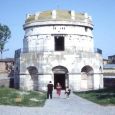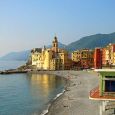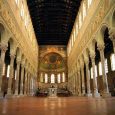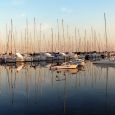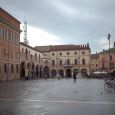Ravenna
Advertisement
By Air
The nearest airports are those of Forli about 20 km from Ravenna.It serves Ryanair.The more expensive airlines fly to Bologna, about 80 km from Ravenna.
By Train
Ravenna railway station has Trenitalia connections to Bologna, Ferrara, Venice, Verona and Rimini.
By Road
can be reached through from the highway hub of Bologna or, from Venice, with State Road 309 "Romea".From Rome the fastest connections is the E45 International Road; the other main connection to southern Italy is the State Street 16 "Adriatica".
By Car
Ravenna is easy to get to from the A14. Follow the signs for A14D from the A14 East.The A14D ends some kilometres before Ravenna, but the roads to the town are clearly signposted.Once in the town, head for the centre (Centro).The town streets vary (as in all Italian towns and cities) with the main routes being large and navigable, the back streets being small and unsuited to large vehicles.As there are a number of ways in, make sure you have a town map before getting to the town, although this is good advice for any Italian town.Parking is easily attained, some free away from the old town centre, and typically 3 euro for 2.5 hours on the main street near the entry to the old town within 200 metres of the Basilica.
Mausoleum of Galla Placidia
is a Roman building in Ravenna, Italy. It was listed with seven other structures in Ravenna in the World Heritage List in 1996. The UNESCO experts describe it as "the earliest and best preserved of all mosaic monuments, and at the same time one of the most artistically perfect".The mausoleum is laid out in a Greek cross plan with a central dome on pendentives and barrel vaults over the four transepts. The exterior of the dome is enclosed in a square tower that rises above the gabled lateral wings. The brick surface is set with narrow mortar joints and decorated with blind arcades.The lunette over the north entrance shows a mosaic of Christ as the Good Shepherd tending his flocks. He holds an imperial staff joined to the Christian cross, symbolizing the combined earthly and heavenly domains. The lunette over the south wall is thought to depict St. Lawrence standing next to a flaming gridiron. On the opposite side of the gridiron a bookcase is shown with four books, each inscribed with the name of an evangelist.The mausoleum is reputed to have inspired American songwriter Cole Porter to compose "Night and Day" while on a 1920s visit.
Mausoleum of Theodoric
is an ancient monument just outside Ravenna, Italy.It was built in 520 AD by Theodoric the Great as his future tomb.The current structure of the mausoleum is divided into two decagonal orders, one above the other; both are made of Istria stone. Its roof is a single 300–ton Istrian stone, 10 meters in diameter. A niche leads down to a room that was probably a chapel for funeral liturgies; a stair leads to the upper floor. Located in the centre of the floor is a circular porphyry stone grave, in which Theodoric was buried. His remains were removed during Byzantine rule, when the mausoleum was turned into a Christian oratory. In the late 19th century, silting from a nearby rivulet that had partly submerged the mausoleum was drained and excavated.An approximate replica of this tomb was constructed in the USA in 1925 when the Taplin Gorge Dam was constructed north of Fergus Falls, Minnesota. The designer (Vernon Wright who was also the president of the dam's owner - the Otter Tail Power Company) based the design of the powerhouse on this mausoleum.
Baptistry of Neon
is a religious building in Ravenna, central Italy.The most ancient monument remaining in the city, it was partly erected on the site of a Roman bath.It is also called the Orthodox Baptistry to distinguish it from the Arian Baptistry constructed on behest of Ostrogothic King Theodoric some 50 years later.The Baptistry is one of the eight structures in Ravenna registered as UNESCO World Heritage Sites. According to the ICOMOS evaluation of this patrimony, "this is the finest and most complete surviving example of the early Christian baptistery" which "retains the fluidity in representation of the human figure derived from Greco-Roman art".
Basilica of Sant Apollinare Nuovo
is a basilica church in Ravenna, Emilia-Romagna (Italy). It was erected by the Ostrogoth King Theodoric as his palace chapel, during the first quarter of the 6th century (as attested in the Liber Pontificalis). This Arian church was originally dedicated in 504 CE to Christ the Redeemer.The entrance of the church is preceded by a marble portico built in the 16th century. Next to the church, on the right side of the portico, stands a round bell tower dating from the 9th or 10th century.When the UNESCO inscribed the church on the World Heritage List, its experts pointed out that "both the exterior and interior of the basilica graphically illustrate the fusion between the western and eastern styles characteristic of the late 5th to early 6th century. This is one of the most important buildings from the period of crucial cultural significance in European religious art".
Church of San Vitale
styled an "ecclesiastical basilica" in the Roman Catholic Church, though it is not of architectural basilica form is a church in Ravenna, Italy, one of the most important examples of early Christian Byzantine Art and architecture in western Europe.The building is one of eight Ravenna structures inscribed on the UNESCO World Heritage List.The church was begun by Bishop Ecclesius in 527, when Ravenna was under the rule of the Ostrogoths, and completed by the 27th Bishop of Ravenna, Maximian in 548 during the Byzantine Exarchate of Ravenna.The architect of this church is unknown.The construction of the church was sponsored by a Greek banker, Julius Argentarius, of whom very little is known, except that he also sponsored the construction of the Basilica of Sant' Apollinare in Classe at around the same time.The final cost amounted to 26,000 solidi (gold pieces).
Basilica of Sant Apollinare in Classe
is an important monument of Byzantine art near Ravenna, Italy.When the UNESCO inscribed eight Ravenna sites on the World Heritage List, it cited this basilica as "an outstanding example of the early Christian basilica in its purity and simplicity of its design and use of space and in the sumptuous nature of its decoration".The imposing brick structure was erected at the beginning of 6th century by order of Bishop Ursicinus, using money from the Greek banker Iulianus Argentarius.It was certainly located next to a Christian cemetery, and quite possibly on top of a pre-existing pagan one, as some of the ancient tombstones were re-used in its construction.The exterior has a large facade with two simple uprights and one mullioned window with three openings.The narthex and building to the right of the entry are later additions, as is the fine 9th century round bell tower with mullioned windows.The church is on a nave and two aisles.An ancient altar in the mid of the nave covers the place of the saint's martyrdom.The church ends with a polygonal apse, sided by two chapels with apses.
Arian Baptistry
was erected by the Ostrogothic King Theodoric the Great between the end of the 5th century and the beginning of the sixth century, at the same time as the Basilica of Sant' Apollinare Nuovo.Theodoric was an Arian and decided to let the Goths (Arians) and the Latins ("orthodox" in the sense that they followed canon doctrine), live together but separately, and so there were separate neighborhoods and separate religious buildings.Near his palace, the king commissioned an Arian cathedral, now called the Church of Spirito Santo, but originally named Hagia Anastasis (Holy Resurrection). It was re-consecrated as the Catholic cathedral of Saint Teodoro (soldier and martyr of Amasea in Porto) in 526.Little remains of the original church after its reconstruction in 1543; some historians speculate that the original mosaics were lost over a thousand years earlier during its Catholic reconstruction due to Arian themes. During this same period, Theodoric also had the baptistry built, today referred to as "of the Arians" in order to distinguish it from the Baptistry of Neon (of the Orthodox) which is about one century older.
Information not available


